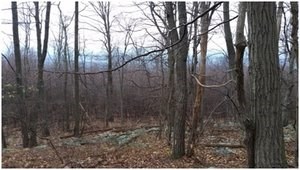In Quest of the "Blue Hawk" on Hawk Mountain
Posted on in In the Field by Dr. Laurie Goodrich, Director of Long-Term Monitoring
Hawk Mountain straddles the Blue Mountain, aka Kittatinny Ridge, which runs 150 miles from New Jersey almost into Maryland and forms a highway for migrating birds. As the southernmost ridge of the Ridge and Valley province, the Blue Mountain seems to mark a border in Pennsylvania’s landscape and nesting bird communities, as it provides a large swath of forest on the periphery of a highly fragmented landscape to the south.

In 1890 B.H. Warren (Birds of Pennsylvania) reported the “Blue Hawk” or Northern Goshawk (Accipiter gentilis) as one of the most rare, and most maligned, raptors nesting in Pennsylvania. A large forest hawk, the Northern Goshawk has always been rare across the state, nesting primarily in large, mature, and mixed conifer-deciduous forests away from human activity. It was most often reported in more remote, less populated northern counties of the state even a century ago. “Maligned” because people disliked the Goshawk’s penchant for eating grouse, rabbits, squirrels, and other birds and regularly shot them on sight until legal protection was enacted in 1960s.
During the 1980s, the Pennsylvania Breeding Bird Atlas recorded 120 possible or confirmed nest locations. But by the 2000s despite greater birder effort, the Second Atlas of Breeding Birds of Pennsylvania (2012, A. Wilson, D. Brauning, and R. Mulvihill authors) reported nesting goshawks had declined by 28% with only 86 sightings or nests. Recently, goshawks disappeared as a nesting bird in Maryland as well (D. Brinker, pers. comm.) suggesting a range retraction or regional decline with reasons or causes remaining as elusive as the bird itself.
Eager to learn more about the distribution of goshawks, Hawk Mountain garnered a small grant from the Kittatinny Coalition and PA DCNR in 2017 (from Kittatinny Ridge conservation initiative led by Audubon Pennsylvania and Appalachian Trail Conservancy) and a grant from the Pennsylvania DCNR Wild Resources Conservation Fund to Penn State University. I and a small group of ornithologists and volunteers began a search for signs of nesting goshawks in Pennsylvania.
One goal of the effort is to try to revisit many of the 100 plus historical nesting territories to see if goshawks still can be found nesting and/or to document habitat attributes or other factors relevant to their presence or absence. Is the habitat still suitable for goshawks? That is just one of the questions we want to answer. The four historical nest sites reported along the Kittatinny Ridge and several areas on the ridge with large unbroken forest are the main priority for Hawk Mountain efforts this spring.
April 12 7:45 am.

Overcast with heavy clouds portending drizzle. My first day afield searching for goshawks. Myself, Rebecca McCabe, and Zach Bordner, a team who has worked for four years studying nesting Broad-winged Hawks, another forest denizen, set out from our vehicle armed with GPS units, tick spray, food and water, binoculars, and our cameras in a quest to revisit a remote historical nest site along the Kittatinny.
After hiking more than a mile we encountered an adult broadwing being chased by crows and jays through the trees. Nearby we found several old stick nests, reminiscent of old nests of broadwings. We examined each nest with our binoculars to see if there was any sign of recent use. Rebecca spotted a few new sticks in one nest and possibly a feather,.. but no other signs of recent use, so she marked it in her GPS unit and we continued on.

Drizzle started at 8:40 am but we continued undaunted. When we reached the coordinates of the historical site, we found a nearby 10-year old forest cut, spanning more than 15 acres but still edged by older forest. Since goshawks can hunt forest cuts, we were not dissuaded. We circled the thick 10-year old vegetation and continued down slope to a dirt access road and found another, larger forest cut. A red-tailed hawk circled above, not a good sign for seeing goshawks here but the birds could have moved. After consulting the map we moved farther east towards a large ravine cut by two to three streams. We hoped to locate mature, more remote forest possibly with a mix of conifers. During the hike we spot several birds, chickadees, a Tufted Titmouse, Downy Woodpecker, White-breasted Nuthatch, Eastern Towhee, Pileated Woodpecker, and hear a Pine Warbler singing in the distance.
After lunch we continue along stream and begin to see occasional hemlocks mixed in with the oak and maple trees, perhaps a good sign! However, our optimism shortly dies as we discover the ravine forest abruptly ends at a newer forest cut extending for more than 50 acres. Our hope for possible goshawk habitat near the area quickly waned. With aching feet we hike back several miles to the vehicle. Six hours and 11 plus miles of forest hiking later, a good workout!
Our report for this site will suggest the habitat appears no longer suitable for goshawks with forest canopy changes, redtails observed, and other evidence of more frequent human activity. However, as Dave Brinker, well-known goshawk researcher, reports, goshawks can shift territories in response to such disruptions.
Our drive home was full of speculation about which nearby secluded forest blocks to search next. Last summer we three had a good look at a goshawk nest when visiting the Allegheny National Forestin northwestern Pennsylvania with researchers Dave Brinker, Don Watts, and Scott Stoleson. The image is riveted in my mind. I was struck by the wild nature of the bird as well as their vulnerability. If we find any nest sites along the Kittatinny Ridge, the sites will remain secret and locations only reported to state agencies so they can be protected from disruption.
The “Blue Hawk” may no longer inhabit the Blue Mountain but we searchers are not giving up hope just yet.To learn more about the goshawk project in Pennsylvania, visit www.pabiologicalsurvey/goshawk.